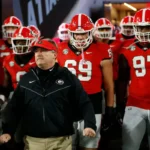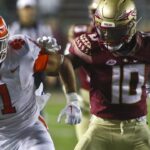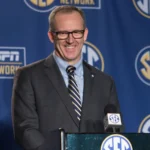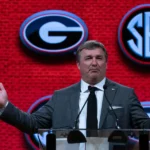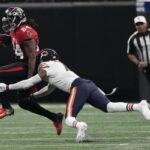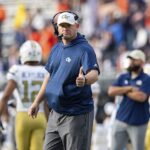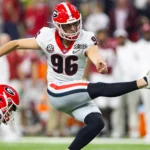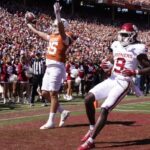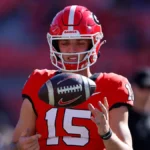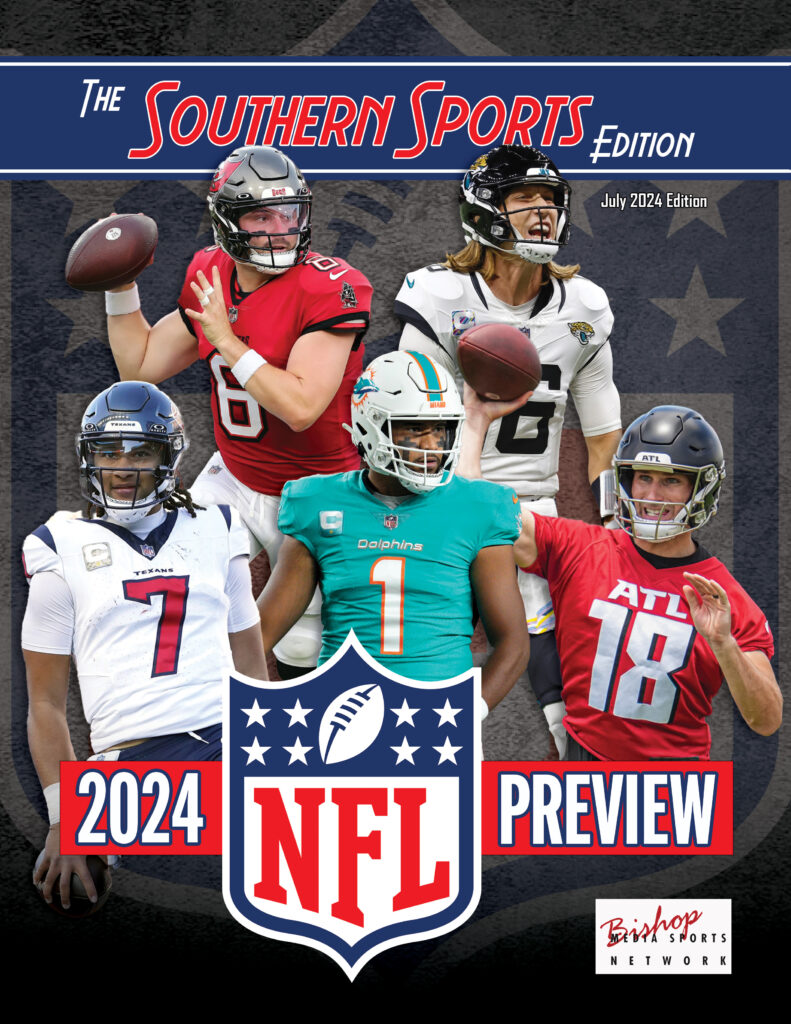College Football
Red Means Stop
 By: Robert Craft
By: Robert Craft
TheSouthernSportsEdition.com news services
Georgia players are facing suspensions for driving violations, coach Kirby Smart confirmed on Tuesday. There has been another internal punishment: fines via the program’s collective, which have been happening for a while, Smart said.
“Our Classic City Collective for over a year has been substantially fining guys for those things,” Smart said. “That’s not something that’s new. That’s something that’s been ongoing outside of my jurisdiction that they decided to implement and have done for a considerable amount.”
Georgia has continued to have problems with driving-related arrests. Seven players have been arrested on driving-related charges since the January 2023 car crash that killed player Devin Willock and staff member Chandler LeCroy in which police found LeCroy had been drinking and racing with then-teammate Jalen Carter.
Safety David Daniel Sisavanh, arrested on reckless driving in February, has been dismissed from the program for what Smart only would term a ‘violation of team rules’.
There have been speeding tickets and arrests for speeding. Another player, Jamon Dumas Johnson, was arrested last year for a street racing incident that happened before Wilcock’s fatal crash.
Smart has declined to specify what the suspensions will be, only confirming them after the fact, such as last year when receiver Marcus Rosemy-Jacksaint was suspended for a speeding arrest.
As this season approaches, running back Trevor Etienne (DUI) and linebacker Smael Mondo (reckless driving, racing) seem likely to face suspensions. But Smart said he would not publicize those suspensions in advance.
“I don’t necessarily think it’s right to go down to the town square and publicly shame kids when that happens,” Smart said. “They go through a lot, and there’s a lot of remorse from these young men who’ve made mistakes. But our job is to educate, continue to grow these young men.”
Still, given all the arrests, following a tragic car crash, how has an otherwise disciplined program failed to curtail this serious issue?
“It’s a great question,” Smart said. “I’d love every solution possible because we actually write down now every time we talk about it and every time we address it, and we have someone in every meeting that hears that, and before I came, it was like 162 times it’s been mentioned. But if people go say, ‘Well, it falls on deaf ears, you got to have discipline, you’ve got to discipline someone.’ Well, we have, and we will continue to do so. If the actions require that, we’ll do what’s necessary to do that. But I do think the effective way in curtailing some things is when you go to their wallet and you find them because these fines have been substantial, and it’ll make you think twice about the mistakes you make.”
Georgia has used what Smart called proactive education, such as defensive driving courses. But Smart also defended the discipline process.
“As far as I know, there’s not one team in the country that’s ever suspended a player for a traffic violation similar to what Marcus Rosemy got suspended for,” Smart said.
“I don’t know if anybody’s ever kicked somebody off the team for that. And we have that. And we’re going to continue to be proactive. Repeated poor behaviors and poor decisions. In some cases, we have repeated behaviors, and in some cases, we have guys that make mistakes, and we’re going to punish them.”
Obviously with the tragedy that happened two years ago, that’s the biggest thing, guys realizing to be intentional in the moment. … It doesn’t matter if you get there five minutes early, it’s not going to change anything. Slow down and follow the rules of the road.
Big 12 Going Big Time?
 By: Robert Craft
By: Robert Craft
TheSouthernSportsEdition.com news services
Before FSU and Clemson can make a single business decision, they have to resolve their lawsuits with the ACC. That could take months if they settle, and years if they have their day in court.
“What’s going to happen?” That’s the $130 million dollar question these days in the Atlantic Coast Conference.
An important date is looming for the entire ACC: February 2025. The day ESPN has a “look-in” and will decide whether they continue the ACC’s contract until 2036.
If relationships were stable (and I mean completely), it would be a no-brainer for Disney to keep things as is. ESPN enjoys the locked-in price, especially with the revenue it makes from the ACC Network.
Considering their current relationship, if the network opts out … chaos in the streets. Today’s dynamic between media companies and NCAA could change in an instant if the ACC implodes.
SEC commissioner Greg Sankey stated at Media Day this week, “Our focus is on our 16 members.”
Big Ten’s Tony Petitti will likely side with Sankey next week, but for different reasons. Big Ten’s focus is not on realignment. There’s no realistic alternative at their level. The Big Ten Conference will likely do whatever Fox tells it to do, and this may well covet a powerhouse program that gets it into a hugely populous state.
That seems a more viable option than the SEC, which already has schools in Florida and South Carolina and whose partner, ESPN, has no incentive to pay more money to show Florida State and Clemson than it does now.
So where do they go? The Big 12 presents an interesting, less plausible alternative. On the one hand, The Big 12 Conference makes no more revenue than the ACC does now, so, what’s the point, right?
If Brett Yormark gets his wish and his presidents sign off on a private equity deal. Florida State and Clemson could get paid a lot more than they make now, and that’s before negotiating a new TV deal.
If the Big 12 follows through, all schools could possibly make Big Ten/SEC money without having to play a Big Ten/SEC schedule.
Why haven’t they done it already? Moving to the Big 12 is challenging. For Florida State and Clemson to be interested in making that move, they likely would demand to be paid closer to what the schools in the biggest two conferences are making each year.
They also would likely ask for financial help to pay their exit fees, penalties, and whatever else they could think of. FSU and Clemson are expensive programs.
While landing the Seminoles and Tigers would definitely be a game-changer for the Big 12 as a conference. At the university-level, teams and offices might balk at receiving significantly lower distributions each year, and we’re back to the unrest we’re at today.
Personally, I find it hard to imagine those schools wanting to join a less-glamorous conference. Perhaps an invite serves as leverage to gain better terms from the ACC.
Dollar Delivery
 By: Robert Craft
By: Robert Craft
TheSouthernSportsEdition.com news services
In Mandalay Bay (Las Vegas) last week, the impending House settlement dominated conversations at the National Association of Collegiate Directors of Athletics convention.
Panels were filled with questions, and not many answers. The top leaders in college sports don’t know the exact date when revenue sharing and the new world order will begin – speculation is the 2025-26 academic year.
Meanwhile, others are trying to figure out how much revenue they can share while keeping an athletic department up and running.
Alongside this, another major question remains: How will revenue actually be split up?
The NCAA and Power 5 conferences voted to sign off on the settlement agreement in May, agreeing to pay $2.77 billion in back damages to athletes over 10 years. The second piece of the agreement is revenue sharing, allowing institutions to pay $20-22 million annually to athletes.
How plaintiff attorneys divide back damages is expected to be how schools approach Title IX. This might shape a framework for revenue sharing. The settlement is on track to disperse 75% of TV revenue in back damages to football. From there, 15% would be funneled to men’s basketball, 5% to women’s basketball and the final 5% divided by the remaining athletes.
As administrators try to figure out how to split up revenue-sharing dollars, if Judge Claudia Wilken ratifies this portion of back damages it’s expected to be looked at as a “framework for the future”, antitrust attorney Jay M. Ezelle believes. The Birmingham, Alabama, based litigator with Starnes Law has advised NIL collectives and institutions in the NIL Era. Additionally, Ezell previously worked on NCAA investigations.
If Wilken ratifies a settlement that follows a similar breakdown of TV revenue, Ezelle believes it could help institutions navigate Title IX
.“Title IX pervades everything you do and an athletic department has to be in compliance with Title IX,” he said. “So, it is thoughtful and the right thing to do to be considerate. This is an issue that has not been litigated. And so, that presents uncertainty.
You have to address that uncertainty. That being said, the people who just say, ‘Let’s just distribute this 50-50 in order to comply with Title IX’ are not looking at the flip side of that. Because if you do it that way, you may actually be in violation of antitrust laws. Because you’re doing something that’s against the market.
The top-funded NIL collectives are spending between $13 to $20 million annually on football rosters at the moment. In basketball, the highest spending programs are pushing $5 million.
Ezelle believes splitting revenue evenly will only necessitate the need for collectives to step up. And it would also open up the possibility for football players to rationalize how much money they’re receiving vs. the revenue they’re producing.
For reference, The Big Ten announced a seven-year, $8 billion media deal with CBS, NBC and Fox in 2022. The SEC starts its new deal with ESPN this season, expected to be worth around $811 million annually.
The industry-wide financial stress test created by the House settlement is forcing campus leaders to look in the mirror and see the same image many have identified for years: bloated athletic departments.
Expenses must be adjusted in a new financial model, of course, and the safe bet is fat will be trimmed behind the desks and not the sidelines – and college sports will continue to flourish.
SEC Media Days
 By: Michael Spiers
By: Michael Spiers
TheSouthernSportsEdition.com news services
If you are a die-hard fan of collegiate sports just like I am, then you certainly feel the current doldrums. The College World Series is over. The volleyball, softball and tennis seasons are in the books. July can feel so empty.
But just when it feels that all hope is lost, we can count on college football Media Days to turn our attention to the unofficial start of the football season, or at least the “talking season”.
With the start of the 2024 college football season just around the corner, the excitement is building as the SEC gets ready for its annual Media Days from July 15-18 in Dallas.
This year’s event is extra special since it’s the first time Texas and Oklahoma will be part of the mix. Each of the 14 schools is sending three players, making up a total of 42 athletes.
Interestingly, 11 quarterbacks will be there, but Tennessee, Vanderbilt, Texas A&M, South Carolina, and Kentucky decided not to send their QBs. Instead, many schools are spotlighting their defensive talent, with 10 linebackers and nine defensive linemen on the list.
SEC Media Days is one of the biggest preseason events where players and coaches chat about their expectations and plans for the upcoming season.
Some of the standout players attending include Alabama’s Jalen Milroe (QB), Arkansas’s Taylen Green (QB), Auburn’s Payton Thorne (QB), Florida’s Graham Mertz (QB), Georgia’s Carson Beck (QB), and LSU’s Garrett Nussmeier (QB). On the defensive side, players to watch include Alabama’s Malachi Moore (DB), Auburn’s Keldric Faulk (DE), Florida’s Shemar James (ILB), and Georgia’s Mykel Williams (DL). Each school is bringing a mix of talent that highlights their strengths and sets the stage for a competitive season.
The coaches will also be there to talk about their teams. Brian Kelly of LSU will start things off on Monday, followed by Lane Kiffin (Ole Miss), Shane Beamer (South Carolina), and Clark Lea (Vanderbilt). On Tuesday, we’ll hear from Kirby Smart (Georgia), Eliah Drinkwitz (Missouri), Brent Venables (Oklahoma), and Josh Heupel (Tennessee). Wednesday’s lineup includes Kalen DeBoer (Alabama), Billy Napier (Florida), Jeff Lebby (Mississippi State), and Steve Sarkisian (Texas). The event wraps up on Thursday with Sam Pittman (Arkansas), Hugh Freeze (Auburn), Mark Stoops (Kentucky), and Mike Elko (Texas A&M).
Besides the formal sessions, the vibe around Media Days is always electric. Fans, media, and analysts are eager to hear from the key players and coaches about their strategies, challenges, and outlooks for the season.
This year’s event promises plenty of buzz and storylines as teams gear up for what’s expected to be an intensely competitive season.
The SEC Network will have extensive coverage all four days. With live broadcasts and analysis, viewers can expect to get insights into each team’s preparations and prospects. Special editions of SEC Now and other shows will provide a platform for expert opinions, predictions, and behind-the-scenes looks at the event.
In short, the 2024 SEC Media Days in Dallas will be a major event featuring a strong lineup of quarterbacks and defensive players from all 14 schools, extensive media coverage, and a stellar roster of coaches ready to discuss the upcoming season. This year’s event highlights the evolving dynamics of the SEC, especially with Texas and Oklahoma joining in, promising an exciting preseason narrative for college football fans.
Get ready for an action-packed week of football talk, star players, and coach insights as the SEC sets the stage for what promises to be an unforgettable 2024 season.
Rule Change
 By: Colin Lacy
By: Colin Lacy
TheSouthernSportsEdition.com news services
With the 2024 season just around the corner, everyone is scouring websites, rosters, and Phil Steele Preseason magazine.
While rosters and coaching staffs in this day-and-age of college football change year to year, there is another aspect that does as well…the rules of the game.
While 2024 High School football will look virtually the same (the only rule change for HS Football is the home team jersey has to be a darker color to contrast with white numbers), there are a couple of key changes in the rule books for both the college and NFL games that will undoubtedly affect the game this year.
Saturdays in college football have seen a “trickle down” effect for rules implemented in the NFL a few years prior but changes this year have taken longer than usual to find their way to the college game. The main changes include the implementation of the 2-minute warning, player-to-coach communication, and tablets on the sidelines.
The 2-minute warning is a term that most football fans have known for a while in the NFL and was first implemented in professional football in 1942.
For the second and fourth quarters of a college football game, there will be an additional timeout at the 2-minute mark for the first time in the history of college football.
The new pair of two-minute stoppages are designed to not only help players and coaches with late game and late half execution while also making it slightly easier for officials when timing changes in the last two minutes of the half (clock stopping on a first down to set the ball).
A couple of technological advances that again stem from the NFL are entering the college game in 2024 as well.
The first that was a hot topic of conversation last season in the Michigan sign-stealing saga of 2023 is coach-to-player communication systems in players helmets.
This is a system that places a speaker in one player’s helmet on the field that allows a coach to speak to that player to call in a play.
These helmets that have the communication device will have the green dot sticker on the back (much like the NFL protocol), and allow a coach to talk into the player’s ear until the system is cut off with 15-seconds remaining in the play-clock or the snap of the ball (whichever happens first).
The other technological advancement is the ability to have tablets on the sideline which will actually give coaches more of a resource than are in the NFL.
NFL Tablets have been on the sideline since 2014, but in the professional side, the tablets only show images and not instantaneous video replays.
The college game will implement the allotted 18 tablets on the sidelines that can view in-game video only from either the broadcast feed as well as coaches video angles from the sideline and endzone.
While the rule modifications for college football are more ancillary, the NFL changes for 2024 affect the game more directly.
The biggest that has been a point of conversation for many years now was the new kickoff rule adjustment that follows a similar format that the XFL spring league used in 2023.
While the kickoff will still take place from the 35-yard line, the remaining 10 members of the kicking team will line up on the opposite 40-yard line. The receiving team will have a minimum of 9 players between the 30 and 35-yard lines with a maximum of 2 players back deep to receive. The play doesn’t begin (meaning players can’t move) until the ball is either caught by a returner or bounces inside the “landing zone” which is defined as the goal line to the 20-yard line. Any kick that touches in the landing zone must be returned (or downed) even if it bounces into the endzone.
The other NFL rule change for the coming fall is the elimination of the “hip-drop” tackle when a defender grabs the runner with both hands or wraps the runner up with both arms, then unweights himself by dropping his lower body AND trapping the runner’s legs at or below the knee underneath.
While there could be some late additions like the NFL experimenting in the pre-season with the chips in the ball to determine a first down, this is the majority of the changes you’ll see this fall.
While the NFL is more an “on-the-field” change, the college game may get talked about more and deeper into the season as an impact of whatever this ever-changing college football landscape looks like.
North Avenue Buzz
 By: Kenneth Harrison
By: Kenneth Harrison
TheSouthernSportsEdition.com news services
Georgia Tech is a great academic institution that has also been known for having strong athletic programs.
They are a program that has multiple national championships on their resume in football and they have played in several bowl games.
Brent Key had his first full season as head coach for the Yellow Jackets last year. Key took over after the 2022 season and he went 4 – 4. He looked like he might find success and he delivered.
Tech went 7–6 overall and 5–3 in the ACC in 2023. On the surface that does not sound impressive, because it’s just one game over .500. This was their first bowl appearance since 2018, which was Paul Johnson’s final season.
They started the season 2 – 3 with an embarrassing home loss to Bowling Green. The highlights of their season were two upsets over North Carolina and Miami, both were ranked 17th at the time of the game.
They played in the Gasparilla Bowl in Tampa, Florida and they beat UCF 30-17. Now the question is can they build on that in 2024?
The transfer portal is huge in college football and unfortunately, the Yellow Jackets are dealing with that. They had 32 players enter the portal ahead of the 2024 season.
Some of the key players leaving are corner back KJ Wallace (UCLA), defensive lineman D’Quan Douse (Michigan State), corner back Kenan Johnson (Utah), defensive end Kyle Kennard (South Carolina), quarterback Zach Wilson (Georgia State), wide receiver Juju Lewis (FIU) and defensive end Malcolm Pugh (Louisiana Tech).
They also acquired players in the transfer portal. They added a few more from the spring. Tight end Josh Beetham (Michigan), safety Jayden Davis (Cincinnati), defensive lineman Thomas Gore (Miami), defensive end Romello Height (USC), cornerback Zachary Tobe (Illinois), linebacker E.J. Lightsey (Georgia), corner back Warren Burrell (Tennessee), defensive lineman Ayobami Tifase (Florida State) and defensive lineman Jordan van den Berg (Penn State).
The Yellow Jackets ranked 120th in total defense last season out of 130 FBS teams. It’s good to see them addressing that side of the ball because they were awful.
Quarterback Haynes King transferred in from Texas A&M. He passed for 2,842 yards, 27 touchdowns and he rushed for 737 yards and 10 TD’s. He did lead the ACC with interceptions so he will need to improve his decision making and cut down on his turnovers. He is one of the best quarterbacks in the conference.
Georgia Tech has a total of 17 starters returning, which is tied for 7th with Cal. They have eight on offense and seven on defense.
That includes most of their offensive line, leading rusher Jamal Haynes and top-two receivers Malik Rutherford and Eric Singleton Jr. Haynes rushed for 931 yards, 7 scores and averaged 6 yards per carry. He had 1,129 all-purpose yards. I think he could have a breakout year in 2024.
The season opens August 24th against Florida State in Dublin, Ireland. FSU will be favored to win this game.
The other games where they will be underdogs are against Notre Dame at Mercedes Benz Stadium and at Georgia.
The games I expect them to win are Georgia State, Syracuse, VMI and Duke.
The other games that are too close to call are Louisville, North Carolina, Virginia Tech, Miami and NC State.
I think they are capable of winning six games again, if they stay healthy.
As of now their 2025 recruiting class is ranked 22nd in the country and that could improve with another good season.
96
 By: Joe Delaney
By: Joe Delaney
TheSouthernSportsEdition.com news services
As we stroll into the dog days of summer, many of us die hard Dawgs look to the upcoming football season while reminiscing about the great run that Georgia has been on. And it has been unquestionably the greatest run in University of Georgia History.
Yes, Wally Butts had some of those great early teams. The Rose Bowl win 9-0 over UCLA and national championship in 1942 was one for the ages.
It would be another 40-some-odd years before Vince, Herschel, Buck, Lindsey and the boys took UGA to the mountain top with the great run beginning with the 1980 national championship win over Notre Dame. Throw in the great games that year with South Carolina and above all Florida and it was a year like no other.
Fast forward to 2015 and enter one Mr. Kirby Smart. Since then, Georgia has been arguably the best college football team in the country.
Into this growing dynasty walks one Jack Podlesny in 2018. And he literally walks in as a walk on.
Coming from Glynn Academy, Jack Podlesny was a known commodity. He had hit 9 out of 10 field goals and 49-51 PATs. He was an all-region soccer player and had great technique. He had offers from Michigan, Georgia Tech and others but chose instead to walk on at the University of Georgia.
Georgia at the time was having a bromance with Rodrigo Blankenship. He was Georgia’s kicker and one of the most popular players on the team, and around the nation. It was hard not to love “Hot Rod” and those horn-rimmed glasses, but his time ran out at Georgia. It was time to find another kicker.
Enter Jack Podlesny. The young kicker redshirted and learned in 2018, backed up Blankenship in 2019, and then the next year won the starting job in preseason and responded by going 13-16 on field goals and nailing all 38 extra points.
It earned him a spot as a Lou Groza Award semifinalist. Who can forget the Peach Bowl and young Jack walking on the field to try a 53-yard game winning field goal with SEVEN seconds left on the clock. The ball is snapped, put down and the national announcer goes…… THERE IT IS…………………. GOT IT!!!! Jack was 3-3 on Field goals in the game and named the Offensive Player of the Game.
Podlesny would go on to be one of the greatest kickers in University of Georgia history. Kevin Butler, Rex Robinson, Blair Walsh, Billy Bennett, Rodrigo Blankenship…. All great players. And yet none have the trophy case that Jack Podlesny has. Two national championship rings, SEC special teams player of the year 2022, first team All SEC 2022, etc etc etc.
By the end of the 2022 season “Hot Pod” would go on to set numerous records including most points scored in a season at UGA. He would light it up for 151 points in 2022 and have the second most points 137 in 2021. He stands second in career field goal percentage to his mentor Blankenship at 82.47 for “Rod” and 82.43 for “Pod”.
While Jack is now with the Green Bay Packers, he recently received another honor that I’m sure he will cherish. UGA Sports just started counting down to the 2024 season by naming the greatest players in Georgia football history by descending numbers worn 99 to 0.
With number 96 worn by Jack Podlesny. A scrawny kid from St Simons, GA who grew up playing youth soccer on Jekyll then football at Glynn Academy.
The best football player in University of Georgia History to wear Number 96.
In The Courts
 By: Robert Craft
By: Robert Craft
TheSouthernSportsEdition.com news services
Big 12 presidents and chancellors voted to approve proposals of what is expected to be a multi-billion dollar settlement in the House v. NCAA class-action lawsuit.
Their approval is another step toward a resolution in the landmark case likely to reshape the college sports business model.
The Big 12 is the first of the suit’s defendants to vote on the settlement terms. The remaining power conferences and NCAA Board of Governors also expected to vote this week.
Settlement details are expected to include north of $2.7 billion in back-pay damages the NCAA will owe to former Division I athletes, as well as a revenue-sharing model between power-conference schools and athletes for NIL deals in the future, according to sources briefed on the negotiations.
The damages, made available to Division I athletes dating back to 2016 as back-pay for lost name, image and likeness (NIL) earning opportunities, would likely be paid out over 10 years via a combination of NCAA reserve funds and reductions in future revenue distributions to conferences.
The revenue sharing would be an optional model for power-conference programs, potentially as soon as next year, in which 22 percent of those schools’ average annual revenue — or roughly $20 million a year — will be distributable directly to athletes.
If finalized, a process that will take several months, the settlement would be the next and most significant overhaul to the long-standing framework of amateurism in college sports.
Once the NCAA and power conferences agree on the terms and both sides in the case sign off, the settlement will be submitted to Judge Claudia Wilken of the U.S. District Court for the Northern District of California for preliminary approval. If that gets granted, there would be a set period of roughly 90 days in which those in the retroactive damages class have an opportunity to opt out, and those in the future revenue-sharing class can object to the terms of the agreement.
That’s followed by a final approving hearing, at which point, if the judge approves, the settlement officially goes into effect.
A settlement would give the NCAA more input on payment structures for the damages and revenue sharing, as well as safeguards against other impending legal battles.
Settling the House case would resolve Hubbard v. NCAA and Carter v. NCAA, two other high-profile antitrust suits in which the plaintiffs are represented by Berman and Kessler in the Northern District of California, and hinder any additional antitrust complaints over the next decade, according to sources briefed on the settlement negotiations.
This is considered an important aspect of the settlement terms for the NCAA, which has faced an onslaught of legal challenges in recent years.
Newly configured roster limits for power-conference sports are also expected as part of the settlement, with specific scholarship figures to be decided collectively by those leagues in the coming months.
The Big 12’s approval comes in the wake of internal dissension within the NCAA in recent days, as the smaller, non-FBS Division I conferences argue that the proposed funding plan for settlement damages puts a disproportionate financial responsibility on them.
Lingering questions also remain beyond the settlement over Title IX’s role in future revenue sharing, the future of third-party NIL collectives and the ongoing debate over unionizing efforts and employment status.
Even though this may be the start of the settlement, we are still far from the future that College Athletes deserve.
SEC QB1
 By: Robert Craft
By: Robert Craft
TheSouthernSportsEdition.com news services
Six quarterbacks were taken in the first round of the 2024 NFL Draft, tying the 1983 class, which included Hall of Famers John Elway, Jim Kelly and Dan Marino.
Despite the college landscape’s losses, SEC Football will have no shortage of talent at QB1 in the 2024 campaign.
From veteran transfers to young standouts, countless QBs are hungry for their shot at glory in the upcoming season. Here are my top 5 SEC quarterbacks heading into 2024-25.
- Garrett Nussmeier (LSU): Nussmeier’s only start last season came in LSU’s victory over Wisconsin in the ReliaQuest Bowl.
In the win, Nussmeier exploded with talent: 31 completions, 395 passing yards and 3 touchdowns. I feel confident Nussmeier can replicate this success next season in an expanded role.
LSU is going to score a lot of points, and, it’s [Nussmeier’s] team now. He knows that. Brian Kelly knows that. Everyone in that locker room knows that. And, I think we got a preview of it during the bowl game.
- Nico Iamaleava (Tennessee):Nico Iamaleava finished last season with 28 completions for 2 touchdowns and no interceptions.
During Tennessee’s 35-0 win over Iowa (Cheez-It Citrus Bowl), Iamaleava completed 12-of-his-19 pass attempts for 151 yards and a touchdown. He also had three scores on the ground. I believe Iamaleava might realize his full potential this season.
- Jalen Milroe (Alabama):Jalen Milroe finished this past season with 2,718 yards passing, 23 touchdowns and just 6 interceptions.
He was also a significant threat on the ground, collecting 468 rushing yards and a team-high 12 touchdowns on the ground.
While Nick Saban is no longer leading the Crimson Tide, My prediction is Milroe will continue to roll over his opponents.
Milroe and Kalen DeBoer, to me, are a lot like the french fry and milkshake combo. It sounds like two things that are very different wouldn’t go well together. I think that’s Kalen DeBoer and Jalen Milroe. You don’t think they’re supposed to go together and then you try it and you’re like, Oh, wow, this is phenomenal.
- Jaxson Dart (Ole Miss):Jaxson Dart led one of the most dangerous offenses in the nation last season.
In 2023, the 6-foot-2 QB recorded 233 completions for 3,364 passing yards and 23 touchdowns while only tossing 5 picks. I am forecasting these numbers will grow in the upcoming season.
1B. Quinn Ewers (Texas):Quinn Ewers threw for 3,161 yards and 21 touchdowns across 11 games as a redshirt sophomore last season, leading Texas to its first College Football Playoff appearance in program history.
Expect even more jaw-dropping statistics from Ewers this year.
Ewers, I think has the ability to have the best statistical performance out of anybody on this list this season. He has figured out what works in college football. The light bulb is on. It’s not blinking. It’s beaming.
1A. Carson Beck (Georgia):Carson Beck finished this past season ranked third nationally and first in the SEC in passing yards (3,941), as well as fourth in the nation in completion percentage (.724).
For his efforts, he was named a Coaches All-SEC Second Team selection. Obviously, I anticipate more accomplishments for Georgia’s QB1.
I have the highest level of confidence that [Beck] is going to execute his job at the highest level every single Saturday..
It’s All About The Money
 By: Robert Craft
By: Robert Craft
TheSouthernSportsEdition.com news services
I believe the official date for Clemson and FSU to inform the ACC of their intended departures for the 2025 season would be Aug. 15.
So, that would mean we would either have some form of resolution in court by then, which is not likely considering how it affects conferences across college football. The only other option, which is more likely, would be to settle out of court.
If it’s the latter, and FSU and Clemson part ways, ESPN will smartly decide in February not to pick up its ACC TV package through 2036.
That would send the ACC into Pac-12 territory, forcing it to sign a cheaper TV deal beyond 2027 (without its two megastars) or a straight-up league breakup in which some could end up fleeing to the Big 12 or even forming a new league.
My guess is there will be a group of ACC schools not getting into the SEC, Big Ten, or Big 12. The remaining teams will want to stick together in some form and take a cheaper TV deal to remain “mid-majors.”
We can sit here and debate which schools those are, or you can simply look at TV ratings and TV markets for the past few years and put two and two together.
Either way, not everyone is getting an invite to the Big 2 or a Super League. If FSU or Clemson has to spend a few years in purgatory (the Big 12) to get to the SEC or Big Ten, they’ll do it to get out of having to stick around in the ACC through 2036.
I just don’t think we’re going to see a 24-team Big Ten or a 24-team SEC down the road. Remember, the SEC’s TV deal runs with ESPN through 2033-34 and the Big Ten’s deal runs with CBS, NBC and Fox through 2029-30.
There’s no incentive for the schools in those leagues to add any more schools when they’ve got such a huge financial advantage in college football, unless they’re competing to sign top “free agent” schools such as FSU and Clemson or another school they value like North Carolina.
That essentially leaves the other ACC programs behind to come up with a solution to remain relevant and fund their athletic programs. The ACC will not completely fold.
Wait, I love this idea. I don’t know how likely it is, but I’m not sure anything in college football could surprise me anymore. Oregon State and Washington State need somewhere to land anyway, and if Clemson and Florida State bounce, the ACC should just lean into being totally unhinged. Give me Pac-12 after-dark vibes, every hour of every day.
